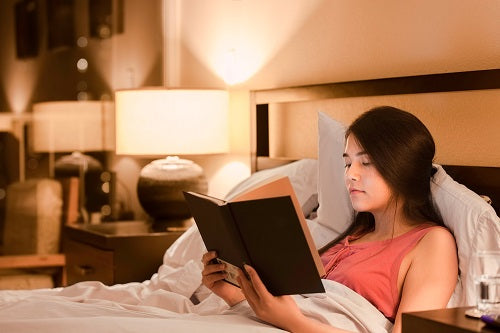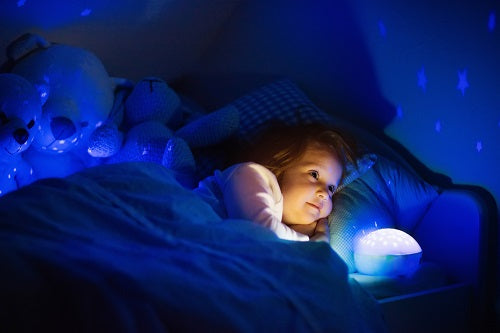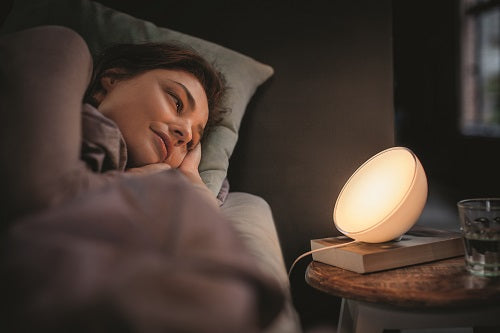A Quick Guide to LED Bedroom Lighting
27 November 2017

Why is lighting important in the bedroom?
It's no secret – the link between quality sleep and improved physical and mental health is more well-known than ever. Creating the right ambience for accommodating a good night's sleep is incredibly important. And while some sleep-related issues may require medical attention, there are several environmental tweaks that you can make to improve your quality of sleep, one of them being the lighting you choose. We know that darkness is essential to sleep, the presence of which sends signals to the brain that it's time to relax. That's why blackout curtains and blinds can help keep intrusive light at bay to help you sleep better. It is also recommended that you prepare your body for sleep by avoiding exposure to bright screens, such as computers and phones; and lowering and softening the light with dimmable bulbs or smart lighting can also help your body prepare physiologically for sleep. It's not just about improving the quality of your sleep either. Clever use of lighting can also help set moods, whether you want a romantic hue for a night in, or you're simply looking to unwind after a long day.
Benefits of LED bedroom lighting
There are a number of reasons to go for LED lighting in your bedroom over traditional lighting methods, such as fluorescent, halogen and incandescent. Here are a few of the main reasons:LED lighting is more efficient
LED lighting uses far less energy than traditional bulbs, so you'll spend far less on your bills. And if you're making the switch from halogen to LED, for example, you'll see your existing expenditure on energy bills plummet. Because they're energy efficient, they're also greener. So, you'll be doing your bit to help the planet too, by reducing your carbon footprint.LED lighting is more versatile
LED lighting has the ability to cast different tones of light, so you can create more bespoke lighting schemes. This is really useful in the bedroom, as you may need areas where a focused shade of light is required, and other areas where a warmer, welcoming shade of light is more befitting. LED lighting is available in the following tones: • Very warm white • Warm white • Daylight • Cool white So, for example, you could have a very warm white bulb by your bed to help you relax or read. While you could use a fresher, cool white bulb in the on-suite bathroom to help kick-start your day the right way under a brighter hue. Using the right shades of light in the right places could help create a relaxing atmosphere and improve your sleep, as well as your day ahead.LED lighting is longer lasting
Not only is LED lighting more efficient than traditional incandescent or halogen lighting, it's also longer lasting. In fact, an LED spotlight will last up 25,000 hours – while a halogen equivalent will just about last 2000 hours if you're lucky. This saves you a significant amount of money when it comes to buying replacements.Types of LED bedroom lighting
Shop our range of LED bedroom lighting here. While it's obviously up to you what type of lighting you use in your bedroom, there are some types that are more commonly used in the bedroom. Here's a selection:Dimmable bulbs
Dimmable bulbs are perfect for setting subtle tones and creating a relaxing ambience, allowing your bedroom to become a retreat after a busy day at work. When buying dimmable bulbs, make sure the bulb is specifically marked as dimmable. You'll also need to ensure your dimmer switch is LED compatible.Night lights
 LED night lights are ideal for children who might be scared of the dark, and useful if you have to get up during the night. Because of the very low brightness at which they operate, they shouldn't inhibit sleep, which standard wall lamps can do.
LED night lights are ideal for children who might be scared of the dark, and useful if you have to get up during the night. Because of the very low brightness at which they operate, they shouldn't inhibit sleep, which standard wall lamps can do.
Standard LED bulbs
One of the best things about LED lighting is that they are available in most standard fittings. Many wall lamps, bed-side lamps and floor lamps – all common fixtures in the bedroom – predominantly feature E27, E14 and B22 bulbs. All of thse are now available in LED form (along with the less popular B15), so if you're replacing older Edison or Bayonet bulbs, you can simply pop in your new LED light bulbs like you would any other bulb.LED filament bulbs
 This is one for the style-conscious. LED filament bulbs are very popular now because they recreate the industrial-era look of traditional fluorescent and incandescent bulbs, while still possessing all the cost-saving benefits of modern LED lighting. Many people opt to fit filament bulbs into exposed wall lamps, pendant fixtures and ceiling fittings to show them in their full-glory. With a whole variety of shapes and styles available, you can create a truly resplendent and unique lighting plan for your bedroom.
This is one for the style-conscious. LED filament bulbs are very popular now because they recreate the industrial-era look of traditional fluorescent and incandescent bulbs, while still possessing all the cost-saving benefits of modern LED lighting. Many people opt to fit filament bulbs into exposed wall lamps, pendant fixtures and ceiling fittings to show them in their full-glory. With a whole variety of shapes and styles available, you can create a truly resplendent and unique lighting plan for your bedroom.
Smart bulbs
Turning your house into a Smart Home is becoming increasingly popular. From Amazon's Alexa to Nest Thermostats, our desire to be more time and energy efficient is leading us to be smarter with how we use basic technologies. So obviously LED lighting was going to get in on the act. The Philips Hue lighting system allows you to remotely manage your lighting needs in a variety of ways to easily reduce energy-use even further and customise your lighting plan – all from the palm of your hand. Through the Philips Hue Bridge – which is the central hub from which you can control your lighting – you can operate up to 50 bulbs from your smartphone or tablet device using the Philips Hue app. Through the app, you can: • Dim your lights to create the perfect ambience for your bedroom • Control up to 50 bulbs simultaneously • Choose from 16 million colours to get really creative wherever and whenever you want to Set-up motion sensor technology, so the lights only come on when someone enters the room – cutting down on energy waste from inadvertently leaving lights switched on.
Through the Philips Hue Bridge – which is the central hub from which you can control your lighting – you can operate up to 50 bulbs from your smartphone or tablet device using the Philips Hue app. Through the app, you can: • Dim your lights to create the perfect ambience for your bedroom • Control up to 50 bulbs simultaneously • Choose from 16 million colours to get really creative wherever and whenever you want to Set-up motion sensor technology, so the lights only come on when someone enters the room – cutting down on energy waste from inadvertently leaving lights switched on.






